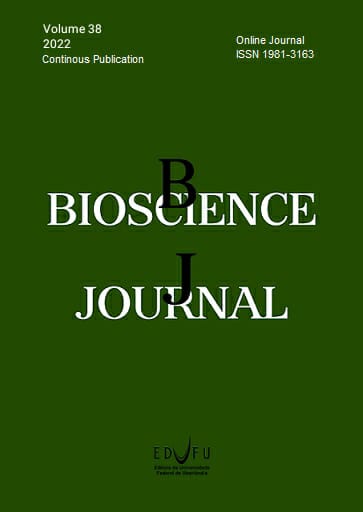Effect of type of mature embryo explants and acetosyringone on agrobacterium-mediated transformation of moroccan durum wheat
DOI:
https://doi.org/10.14393/BJ-v38n0a2022-54513Keywords:
Agrobacterium tumefaciens, Drought Tolerance, Genetic Transformation, HVA1 Gene, Triticum turgidum L.Abstract
Drought is one of the major constraints in durum wheat production in the Mediterranean Basin. In order to overcome this problem, the genetic transformation of durum wheat is one of the choices for improvement. However, the recalcitrance to Agrobacterium-mediated transformation in durum wheat (Triticum turgidum L.) is one of the factors limiting a successful genetic transformation. The aim of this study was to investigate the effect of explant type and acetosyringone concentration for the efficient Agrobacterium-mediated genetic transformation of three Moroccan durum wheat varieties (Amria, Chaoui, and Marouane). The mature embryos (intact, halved and pieces) were inoculated with Agrobacterium tumefaciens strain EHA101 harboring the binary vector pTF101.1 containing drought tolerance gene HVA1 from barley, and a selectable marker phosphinothricin (PPT) resistance (bar) gene. The explants were inoculated with A. tumefaciens (cell density OD650 at 0.7) at four different concentrations of acetosyringone (0, 100, 200, and 400 µM). The results showed that embryogenic calli from mature embryos showed higher regeneration and transformation than mature embryo halves and pieces. The integration of the transgene was confirmed by PCR amplification using primers specific to the bar gene, 2x35S promoter, and HVA1 gene. The transformation efficiency ranging from 0.33% to 2.33% was obtained in Amira variety using embryogenic calli and acetosyringone concentrations of 200 and 400 µM. The integration, as well as inheritance of the transgene, was confirmed by PCR amplification in T0 and T1 generations. This is the first report describing a genetic transformation of Moroccan durum wheat varieties via Agrobacterium tumefaciens.
References
AADEL, H., et al. Agrobacterium-mediated transformation of mature embryo tissues of bread wheat (Triticum aestivum L.) genotypes. Cereal Research Communications. 2018, 46(1), 10-20. https://doi.org/10.1556/0806.45.2017.055
ABDELWAHD, R., et al. Cloning the construct HVA1 into a binary vector by Gateway multisite System and genetic transformation of faba bean (Vicia faba L.) with HVA1 gene for improving drought tolerance. Al Awamia Moroccan Journal of Agricultural Research. 2013, 27,3-20.
BOMMINENI, V., JAUHAR, P. and PETERSON, T. Transgenic durum wheat by microprojectile bombardment of isolated scutella. Journal of Heredity. 1997, 88(6), 475-481. https://doi.org/10.1093/oxfordjournals.jhered.a023140
CHENG, M., et al. Genetic transformation of wheat mediated by Agrobacterium tumefaciens. Plant Physiology. 1997, 115(3), 971-980. https://doi.org/10.1104/pp.115.3.971
CHENG, M., et al. Factors influencing Agrobacterium-mediated transformation of monocotyledonous species. In Vitro Cellular & Developmental Biology Plant. 2004, 40(1), 31-45. https://doi.org/10.1079/IVP2003501
DAI, S., et al. Comparative analysis of transgenic rice plants obtained by Agrobacterium-mediated transformation and particle bombardment. Molecular Breeding. 2001, 7(1), 25-33. https://doi.org/10.1023/A:1009687511633
HAKAM, N., UDUPA, S.M., IBRIZ, M. and IRAQI, D. Optimization of genetic transformation Mediated by particle bombardment of mature embryo of durum wheat (Triticum Durum) genotypes. American Journal of Scientific Research. 2016, 108, 29-36.
HE, Y., et al. Agrobacterium-mediated transformation of durum wheat (Triticum turgidum L. var. durum cv Stewart) with improved efficiency. Journal of Experimental Botany. 2010, 61(6),1567–1581. https://doi.org/10.1093/jxb/erq035
IRAQI. D., HAKAM, N., LABHILILI, M. Transformation génétique des embryons immatures du blé tendre (Triticum aestivum) et du blé dur (Triticum durum) (Genetic transformation of immature embryos of bread wheat (Triticum aestivum) and durum wheat (Triticum durum)). Al Awamia Moroccan Journal of Agricultural Research. 2005, 115(2), 3-16.
JONES, H.D., DOHERTY, A. and WU, H. Review of methodologies and a protocol for the Agrobacterium-mediated transformation of wheat. Plant Methods. 2005, 1(1),5. https://doi.org/10.1186/1746-4811-1-5
MANFROI, E., et al. Acetosyringone, pH and temperature effects on transient genetic transformation of immature embryos of Brazilian wheat genotypes by Agrobacterium tumefaciens. Genetics and Molecular Biology. 2015, 38(4), 470-476. https://doi.org/10.1590/S1415-475738420150026
MURASHIGE, T., SKOOG, F.A. revised medium for rapid growth and bioassays with tobacco tissue cultures. Physiologia Plantarum. 1962, 15(3), 473-497. https://doi.org/10.1111/j.1399-3054.1962.tb08052.x
PATNAIK, D., VISHNUDASAN, D., KHURANA, P. Agrobacterium-mediated transformation of mature embryos of Triticum aestivum and Triticum durum. Current Science. 2006, 91(3), 307-317.
RASHID, H., CHAUDHRY, Z., HAROON KHAN, M. Effect of explant plant source and acetosyringone concentration on transformation efficiency of wheat cultivars. African Journal of Biotechnology. 2011, 10(44), 8737-8740. https://doi.org/10.5897/AJB10.770
REUTERS. Morocco wheat production seen flat in 2018/19. 2018. Available from: https://af.reuters.com/article/moroccoNews/idAFL8N1TL51N
SHRAWAT, A.K. and LÖRZ, H. Agrobacterium‐mediated transformation of cereals: a promising approach crossing barriers. Plant biotechnology Journal. 2006, 4(6), 575-603. https://doi.org/10.1111/j.1467-7652.2006.00209.x
UDUPA, S.M., WEIGAND, F., SAXENA, M., KAHL, G. Genotyping with RAPD and microsatellite markers resolves pathotype diversity in the ascochyta blight pathogen of chickpea. Theoretical and Applied Genetics. 1998, 97(1-2), 299-307. https://doi.org/10.1007/s001220050899
USDA-FAS. Morocco: grain and feed. 2019. Available from: https://www.fas.usda.gov/data/morocco-grain-and-feed-update-12
VASIL, V., et al. Stably transformed callus lines from microprojectile bombardment of cell suspension cultures of wheat. Nature Biotechnology. 1991, 9(8), 743-747. https://doi.org/10.1038/nbt0891-743
VASIL, V., CASTILLO, A.M., FROMM, M.E. and VASIL, I.K. Herbicide resistant fertile transgenic wheat plants obtained by microprojectile bombardment of regenerable embryogenic callus. Nature Biotechnology. 1992, 10(6), 667-674. https://doi.org/10.1038/nbt0692-667
WORLDGRAIN.COM. Morocco’s wheat production to hit historic low. 2020. Available from: https://www.world-grain.com/articles/13887-moroccos-wheat-production-to-hit-historic-low
WANG, Y., et al. Transgenic wheat plants derived from Agrobacterium-mediated transformation of mature embryo tissues. Cereal Research Communications. 2009, 37(1), 1-12. https://doi.org/10.1556/CRC.37.2009.1.1
WU, H., DOHERTY, A. and JONES, H.D. Efficient and rapid Agrobacterium-mediated transformation of durum wheat using additional virulence genes. Transgenic Research. 2007, 17(3), 425-436. https://doi.org/10.1007/s11248-007-9116-9
WU, H., SPARKS, C.A., AMOAH, B. and JONES, H.D. Factors influencing successful Agrobacterium-mediated genetic transformation of wheat. Plant cell reports. 2003, 21(7), 659–668. https://doi.org/10.1007/s00299-002-0564-7
Downloads
Published
Issue
Section
License
Copyright (c) 2022 Khadija Ahansal, Rabha Abdelwahd, Sripada Mahabala Udupa, Hanane Aadel, Fatima Gaboun, Mohammed Ibriz, Driss Iraqi

This work is licensed under a Creative Commons Attribution 4.0 International License.





